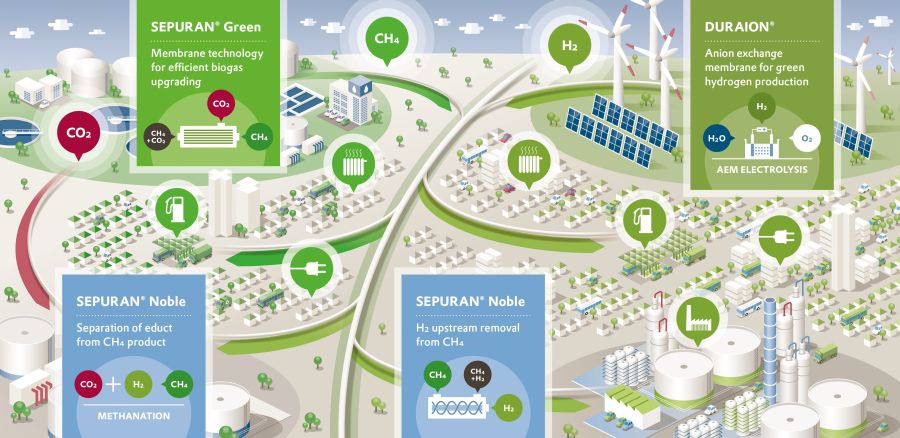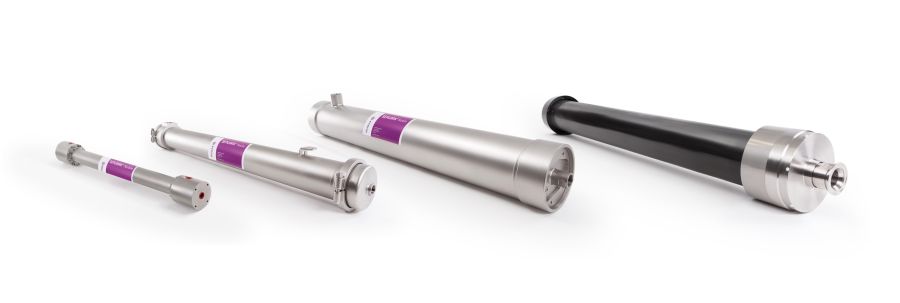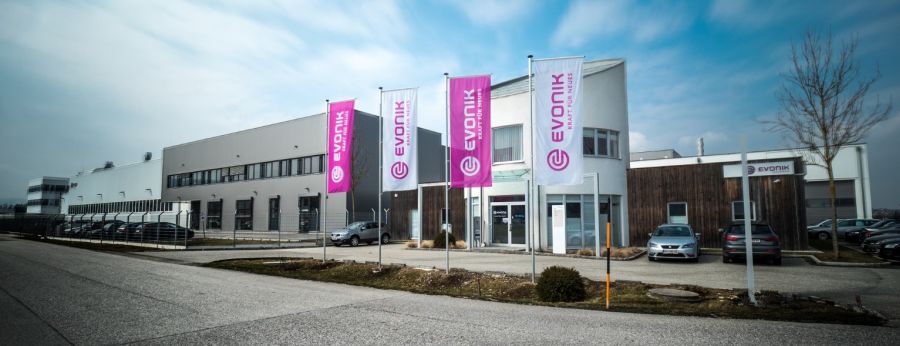By Matjaž Matošec
It was only in 2010 that Evonik launched SEPURAN® Green, its first membrane, which has revolutionised biogas upgrading. Since then, the SEPURAN® family of hollow-fibre membranes has grown substantially and now includes modules for the separation, recovery and/or purification of many other gases, including hydrogen. The company’s latest product is the flat-sheet anion exchange membrane DURAION® for the next generation of electrolytic hydrogen production.
To learn more about these innovations, we spoke with Goetz Baumgarten, Vice President of Membranes at Evonik.
Polymer expertise
Mr. Baumgarten joined Evonik (then Degussa) in 2005, and it was around that time that the foundations of the membrane business were being laid. “The idea to become a membrane producer was triggered by the discovery that our polymers had been coming back to us in the form of membranes as part of installations used in our own operations,” he recollects. “We then quickly realised that our polymer expertise, gas-processing know-how, R&DI excellence, and manufacturing capabilities provide us with everything that is required to develop and produce membranes that are superior to those already available in the market. It was clear to us that by going one step further in the value chain, through forward integration, we could harvest the full separation potential hidden our polymers. This was our starting point and remains the backbone of our business to the present day.”
Competitive advantages
As one of the largest specialty chemicals companies in the world, Evonik is a major player in the global polymer market. Not surprisingly, for a manufacturer of polymer-based membranes, expertise in polymer chemistry constitutes a crucial competitive advantage. Mr. Baumgarten, who holds a PhD in engineering, explains why: “Firstly, we have high-performance polymers designed to withstand extreme conditions. To be honest, our polymers are much tougher than what is actually needed in membrane production, but we can take advantage of their properties and stability when producing and crosslinking the membranes.
“Secondly, our ability to engineer polymers that are meant to become membranes for specific applications with very specific properties is what sets us apart from our competitors. For example, if a polymer designed and manufactured by one company is turned into a membrane for a certain application by another company, then every tweak made to the polymer affects the membrane performance. Unlike others, we design the entire polymer production process in such a way that we achieve extremely stable production. This in turn results in high-quality separation products, because the polymer is designed to run through this customised membrane production process.”

From start-up to market leader
When entering the membrane business in 2010 as a complete newcomer, Evonik joined the innovation race not as a follower but immediately as a market disruptor. Instead of developing its first membrane product for an established market segment, the company created an entirely new one. With more than 800 biogas upgrading plants equipped with SEPURAN® Green membranes worldwide, Evonik is today an undisputed leader in the market segment it created itself.
“In the past, raw biogas was typically upgraded to biomethane by one of three long-established processes: pressurized water scrubbing, pressure swing adsorption (PSA), or amine scrubbing,” explains Mr. Baumgarten. “With SEPURAN® Green, we have developed and patented a novel, three-stage biogas upgrading process that makes it possible to obtain biomethane with a purity level of up to 99% from raw biogas with just one compression step. Compared to other process, our membrane technology has multiple advantages: it requires no consumables, chemicals, or wastewater treatment and is extremely energy efficient. On top of that, it has proven to be extremely durable: after more than a decade since the first installation and with more than 1,000 installations in operations globally, there is still hardly any membrane replacement business. Our first membrane innovation has turned out to be such a great success that all membrane manufacturers are now following us into the biogas market.”
You are currently viewing a placeholder content from YouTube. To access the actual content, click the button below. Please note that doing so will share data with third-party providers.
More InformationProduct diversification
If viewed as a proof of concept, SEPURAN® Green could not have been more successful. Following its launch in 2010/2011, Evonik began exploring opportunities in more traditional markets. Despite facing competition from well-established players, the company’s membrane portfolio was soon diversified to cover other gases such as helium (SEPURAN® Noble), nitrogen (SEPURAN® N2), and natural gas (SEPURAN® NG).
“Knowing that entering existing markets would be more challenging, we pushed ourselves to develop innovative products at the cutting edge of membrane technology,” says Mr. Baumgarten. “For instance, our membranes have exceptional efficiency in nitrogen generation and enable particularly selective separation of sour gases from natural gas. And in helium, we bring such an extraordinary selectivity to the market that cryogenic technologies can be replaced with a membrane/PSA combination, which is an extremely efficient way to extract helium from natural gas. Contributions like these have helped us not only to establish ourselves as a truly relevant player in all gas separation markets, but also to pave the way for the green gas economy.”

SEPURAN® Noble for H2 recovery
A further step in this direction was marked by the launch of the SEPURAN® Noble membrane for hydrogen recovery in 2018. The first uses of membranes to recover hydrogen from ammonia and methanol plants date to the 1980s, making hydrogen one of the first applications for industrial gas separation membranes. The highly selective and efficient SEPURAN® Noble membrane is capable of extracting hydrogen at a concentration level of more than 90%. However, certain hydrogen applications such as fuel cells require a hydrogen purity of up to 99.9999%. To make this achievable, Evonik has partnered with Linde Engineering. Together, they have developed a product that combines two mature, state-of-the-art technologies: Linde’s PSA process and Evonik’s membrane technology.
Earlier this year, Linde started up a demonstration plant in Dormagen, Germany, to showcase how hydrogen can be separated from natural gas stream using HISELECT® powered by Evonik’s membrane technology. In Mr. Baumgarten’s view, this new technology has the potential to become a major accelerator for the hydrogen sector.
“In just a few months, we have had multiple reference site visits at the pilot plant in Dormagen, which demonstrates an enormous interest in this new technology. Why? In the absence of better alternatives, gas grid operators were considering either building entirely new pipelines for hydrogen transport or repurposing existing natural gas pipelines to transport pure hydrogen. Our technology brings to the table an extremely efficient and easily implementable solution that allows grid operators to use existing pipeline infrastructure to transport both natural gas and hydrogen.”

DURAION® for next-gen H2 production
Among the technologies that promise to significantly reduce the cost of green hydrogen production is anion exchange membrane (AEM) water electrolysis, which combines the advantages of the incumbent alkaline and proton exchange membrane (PEM) water electrolysis systems. The main challenge in AEM development has been to achieve high conductivity without compromising on the chemical stability and mechanical integrity. In tests conducted with market-leading partners, Evonik’s DURAION® membrane has now demonstrated supreme conductivity and stability over several thousand hours of operation, paving the way to mass deployment and adoption of this breakthrough technology.
“Durability is certainly a key feature of our DURAION® membrane. Based on a dedicated, high-performance polymer, it is extremely robust and capable of withstanding the harsh, caustic environment and electrolyser conditions. None of the anion conducting membranes made it into a long-lasting equivalent of the market-leading proton exchange membranes – until DURAION®. Having compared DURAION® with other similar products, our industrial partners have concluded that our product is superior, which confirms that we have developed something that is highly attractive to the market. This is why we are now directing all efforts into ramping up production, to bring DURAION® out to the market and unleash a new generation of green hydrogen production.”
Recently, Evonik ordered the first electrolyser intended for its own use. With a generation capacity of 50,000 m3 of hydrogen per year, the electrolyser is to be installed at Evonik’s production and research centre in Hanau, Germany. Crucially, the AEM system will incorporate the DURAION® anion exchange membrane, marking an important milestone in the deployment of AEM technology.
Ramping up production capacity

Committed to growing its membrane business, Evonik is continuously investing in both R&DI and production capacity. Currently, a new production line is under construction at its Austrian plant in Schörfling, where Evonik manufactures SEPURAN® membranes. Expected to be commissioned in early 2023, the new line will ensure that the company can meet and support the growing demand for its gas separation membranes.


